Amur
2007 Schools Wikipedia Selection. Related subjects: Geography of Asia
| Amur | |
|---|---|
|
|
|
| Origin | The mountains of Northeastern China |
| Mouth | The Pacific Ocean, through the Tartar Strait |
| Basin countries | China, Russia, Mongolia |
| Length | 4,444 km (2,761 mi) |
| Basin area | 1,855,000 km² (716,200 mi²) |
The Amur River (Russian: Амур; Simplified Chinese: 黑龙江; Traditional Chinese: 黑龍江; pinyin: Hēilóng Jiāng, or "Black Dragon River"; Mongolian: Хара-Мурэн, Khara-Muren or "Black River"; Manchu: Sahaliyan Ula, literal meaning "Black River") is Earth's eighth longest river, forming the border between the Russian Far East and Manchuria in China.
In many historical references these two geopolitical entities are known as Inner Manchuria; and Outer Manchuria ( Russian Manchuria), respectively. The Chinese province of Heilongjiang on the south bank of the river is named after it, as is the Russian Amur Oblast on the north bank.
The Amur River is a very important symbol of — and an important geopolitical factor in — Chinese-Russian relations. The Amur was especially important in the period of time following the Sino-Soviet political split in the 1960s.
The name Black River was used by the Manchu and the Qing Dynasty who always regarded this river as sacred.
The economy of the Amur Basin includes manufacturing, metallurgy, iron mining, non-ferrous metals, gold, coal, hydroelectricity, wheat, millet, soybeans, fishing, timber and Chinese-Russian trade. The Daqing oilfield, which is the world's 4th-largest oilfield, is located near Daqing City in Heilongjiang, a few hundred kilometers from the river.
Flowing across northeast Asia for over 4400 km (2,700 mi), from the mountains of northeastern China to the Sea of Okhotsk (near Nikolayevsk-na-Amure), it drains a remarkable watershed that includes diverse landscapes of desert, steppe, tundra, and taiga, eventually emptying into the Pacific Ocean through the Strait of Tartary, where the mouth of the river faces the northern end of the island of Sakhalin. The Amur has always been closely associated with Sakhalin, and most names for the island, even in the languages of the indigenous peoples of the region, are derived from the name of the river: "Sakhalin" derives from a Tungusic dialectal form cognate with Manchu sahaliyan ("black," as in sahaliyan ula, "Black River"), while Ainu and Japanese "Karaputo" or " Karafuto" is derived from the Ainu name of the Amur or its mouth.
The average annually discharge varies from 6000 m³/s (1980) - 12000 m³/s (1957), leading to an average 9819 m³/s or 310 km³ per year. The maximum runoff measured occurred in Oct 1951 with 30700 m³/s whereas the minimum discharge was recorded in March 1946 with a mere 514 m³/s.
The Amur proper is 2,874 km long after the junction of two rivers:
- Northern tributary: the Shilka, originating from the eastern slopes of Kente Mountain in Mongolia.
- Southern tributary: the Argun, originating on the western slopes of the Great Khingan Range (大興安嶺) in northeast China.
The Shilka and the Argun join at Moguhe Village (洛古河村), in western Mohe County (漠河县) in Heilongjiang Province, China, and become the Amur proper.
Major tributaries are:
- the Shilka,
- the Argun,
- the Zeya,
- the Bureya,
- the Sunggari,
- the Ussuri,
- the Amgun
The Amur is bordered by Heilongjiang province of China in the south, and Amur Oblast, Jewish Autonomous Oblast, and Khabarovsk Krai of Russia in the north. The final stretch of the Amur passes through Khabarovsk Krai. It passes by the following cities:
- Huma (China, south bank)
- Blagoveshchensk (Russia, north bank)
- Heihe (China, south bank)
- Jiayin (China, south bank)
- Tongjiang (China, south bank)
- Fuyuan (China, south bank)
- Khabarovsk (Russia, south bank)
- Komsomolsk-na-Amure (Russia, north bank)
- Amursk (Russia, north bank)
- Nikolayevsk-na-Amure (Russia, north bank)
Trivia
- A reference was made to this river in the 2003 film The League of Extraordinary Gentlemen.
- In a RPG game namely Suikoden III, Amur is one of the region in Grasslands.

